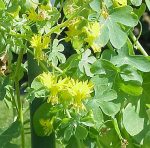 Also known as canarybird flower, canary bird vine, and canary nasturtium, this tender perennial vine is native to western South America, in Peru and possibly Ecuador. It belongs to the nasturtium family, Tropaeolaceae, a family of one genus and about 80 herbaceous species. The plants grow up to 12′ tall and scramble over other plants or garden structures bearing blue-green, shield-shaped, palmately lobed leaves that are rounded and joined in the center to the petiole. Each leaf is up to 2″ across and deeply divided with 3-7 lobes, usually 5. The bright yellow, spurred flowers are 1 ” long and appear in summer. They consist of 3 small lower petals and 2 larger erect frilled ones that resemble the wings of a canary. Canary creeper is a good choice for an arbor, trellis, pergola, wall and border. The genus name, Tropaeolum, is the diminutive of the Latin word tropaeum meaning trophy. The specific epithet, peregrinum, is the Latin word meaning foreign or exotic.Type: Tender perennial
Also known as canarybird flower, canary bird vine, and canary nasturtium, this tender perennial vine is native to western South America, in Peru and possibly Ecuador. It belongs to the nasturtium family, Tropaeolaceae, a family of one genus and about 80 herbaceous species. The plants grow up to 12′ tall and scramble over other plants or garden structures bearing blue-green, shield-shaped, palmately lobed leaves that are rounded and joined in the center to the petiole. Each leaf is up to 2″ across and deeply divided with 3-7 lobes, usually 5. The bright yellow, spurred flowers are 1 ” long and appear in summer. They consist of 3 small lower petals and 2 larger erect frilled ones that resemble the wings of a canary. Canary creeper is a good choice for an arbor, trellis, pergola, wall and border. The genus name, Tropaeolum, is the diminutive of the Latin word tropaeum meaning trophy. The specific epithet, peregrinum, is the Latin word meaning foreign or exotic.Type: Tender perennial
Bloom: Bright yellow flowers with 2 petals that resemble the wings of a canary, in summer
Size: 10-12’H
Light: Full sun
Soil: Average, medium moist, well-drained
Hardiness: Zones 9-11
Care: Low maintenance
Pests and Diseases: Generally healthy but susceptible to damage by aphids, caterpillars, and fleabeetles.
Propagation: Seed
Companion Plants: Orange clock vine (Thunbergia gregorii), Chilean glory flower (Eccremocarpud scaber), nasturtium (Tropaeolum maius), Salvia mexicana ‘Limelight’.
Outstanding Selections: Unknown
Photo Credit: Wikipedia